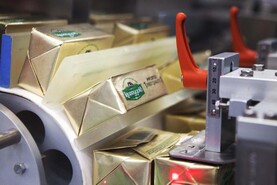Profitability on local dairy farms is forecast to improve in the 2024-25 financial year, according to economic modelling carried out by a leading farm consultancy firm.
Michael Haverty from The Andersons Centre outlined the figures at last week’s Irish Farmers Journal spring conference, organised in partnership with the Livestock and Meat Commission.
The projections are based on a typical 150-cow dairy herd in NI. The theoretical farm extends to 96ha in size, is part rented, has an all-year-round calving system, and mainly uses family labour with a casual worker also employed.
“The situation is expected to improve for 2024-25 as milk prices improve slightly and costs fall somewhat, although careful cost management will still be crucial,” Haverty said.
An average milk price of 37.6p/l is forecast for the farm in 2024/25, which is up from 36.3p/l the year before.
Variable costs are down by 0.9p/l and fixed costs are 0.5p/l lower than 2023-24, standing at 17.9p/l and 15.2p/l, respectively. It means the production margin stands at 1p/l in 2024-25, up from a loss of 1.6p/l the previous year.
When the Basic Payment is included, business surplus is forecast to stand at 2.7p/l, which equates to around £30,000 on top of drawings. The figure is up from 0.4p/l in 2023-24, although it remains well short of the 5p/l seen in 2022-23 when average milk price was 46.7p/l.
Milk price and BPS
On milk prices, Haverty points out that international dairy markets have moved upwards in recent months, although he said some issues remain, particularly “lacklustre demand from China”.
“The extent to which milk prices can go back up to what we saw in 2022 is limited. It will be more of a slower, steadier price increase over the months ahead,” he said.
With margins remaining relatively tight for the model dairy farm, Haverty suggested the Basic Payment still has an important role in delivering surplus cash on top of profit from production.
Direct payments in NI are being cut by 9% this year to fund the new Beef Carbon Reduction Scheme and more cuts will be applied in subsequent years for the upcoming Suckler Cow Scheme and Farming with Nature package.
“If direct support decreases significantly and cannot be recovered by participating in other schemes, this will constitute another risk factor for the dairy farm when it makes losses from production,” Haverty said.
Unlike other farming sectors, the Andersons Centre forecast that post-Brexit trade deals will not have a negative impact on the UK dairy sector.
Its models assessed the effect of the Australia and New Zealand trade deals, as well as potential agreements with Canada and the Gulf Cooperation Council.
ADVERTISEMENTIt found that economic output from UK dairying increases by 3% under a “low liberalisation” scenario and rises by 9% under “high liberalisation” where more trade takes place under the new deals.
Haverty said that under both scenarios, a potential deal with the six Arab countries in the Gulf Cooperation Council leads to “increased exports” from the UK dairy sector.






 This is a subscriber-only article
This is a subscriber-only article











SHARING OPTIONS: